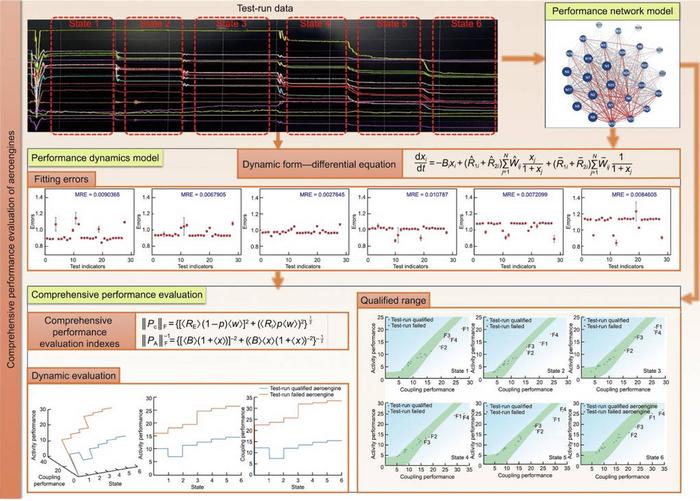
A recent publication in the journal Engineering has presented an innovative and comprehensive framework for evaluating the performance of aeroengines, which are vital components in aviation that ensure the safe and efficient operation of aircraft. This groundbreaking study, led by Shubin Si and a diverse team of researchers from prominent Chinese institutions, addresses the many challenges faced in accurately assessing how these complex engines perform under various conditions.
Aeroengines, as an integral part of modern aviation, require rigorous evaluation processes to maintain flight safety and operational efficiency. Traditional methods have often relied on simplistic metrics such as exhaust gas temperature or were limited to typical operating conditions. However, these approaches inadequately capture the intricate and interconnected nature of aeroengine dynamics, which involve multiple parameters that can influence each other in non-linear ways.
To overcome these limitations, the researchers have developed a unified performance evaluation framework that significantly enhances the assessment capabilities of these engines. Central to their methodology is the construction of a performance network model, which serves as a sophisticated tool for visualizing the intricate relationships among various test indicators derived from aeroengine test runs. By treating these indicators as nodes within a network, the team elucidated the complex dynamics at play within aeroengines, such as the correlation between low-pressure compressor rotor speed and high-pressure compressor rotor speed. They found that changes in one often lead to corresponding changes in the other, highlighting the interdependency of these parameters.
Additionally, the study introduces a performance dynamics model grounded in differential equations, enabling a detailed simulation of how test indicators evolve over time. This model incorporates parameters such as thrust and inlet guide vane (IGV) angle, allowing for the generation of a comprehensive representation of the engine’s performance across various operational scenarios. Remarkably, the fitting errors for the model were generally less than 1%, showcasing its high level of accuracy and reliability in predicting engine behavior.
Crucially, the researchers established new comprehensive performance evaluation indexes, which provide a dual-dimensional perspective on aeroengine performance. This includes coupling performance, which assesses how well different components of the engine work together, and activity performance, which evaluates the engine’s overall operational effectiveness. Through their analysis of 17 different engines—13 that passed testing and 4 that did not—they demonstrated that these indexes effectively differentiate between successful and failed test runs. Notably, engines exhibiting whole-machine vibration displayed elevated coupling and activity performance indexes, underscoring the practical utility of these new assessment tools.
Beyond merely evaluating performance, this innovative approach allows for predictions regarding engine performance under varying conditions, including different combinations of thrust and IGV angles. This provides a far broader evaluative scope than traditional methods, which often restrict assessments to a narrow band of typical operating conditions, resulting in a more nuanced understanding of engine capabilities.
The implications of this research extend deeply into the realms of Prognostics and Health Management (PHM) and digital engineering for aeroengines. By providing a more objective, interpretable, and dynamic means of evaluating engine performance, the study sets the stage for major advancements in predictive maintenance strategies. This is particularly significant as the demand for more reliable air travel continues to grow globally, positioning the insights gained from this study at the forefront of ensuring the safety and reliability of future aviation practices.
Moreover, this study can pave the way for further enhancements in engine design and development processes. By integrating these comprehensive performance evaluation techniques from the onset, manufacturers can create engines that not only meet current performance metrics but also excel in real-world operational conditions. This paradigm shift in evaluation methods may challenge conventional manufacturing practices and encourage a more holistic approach to aeroengine design.
As the aviation sector grapples with emerging challenges, such as increasing air travel demands and the need for sustainable practices, adopting such advanced performance evaluation frameworks becomes paramount. The ability to accurately model and assess engine performance can significantly influence operational efficiency and safety protocols, ultimately contributing to more environmentally friendly aviation solutions.
The research article titled “Data Driven Comprehensive Performance Evaluation of Aeroengines: A Network Dynamic Approach,” highlights the collaborative efforts of an esteemed group of researchers including Yuting Wang, Feng Liu, Feng Xi, among others. It represents a significant contribution to the field, presenting methodologies that have the potential to influence both academic and industrial practices in the area of aerospace engineering.
In conclusion, this groundbreaking framework for evaluating aeroengine performance promises not only to enhance our understanding of complex engine behaviors but also to radically improve the way engines are monitored, maintained, and developed in the ever-evolving landscape of aerospace technology. The results of this research could lead to heightened safety standards and more reliable engines, ultimately contributing to the future of air travel.
Subject of Research: Comprehensive performance evaluation of aeroengines
Article Title: Data Driven Comprehensive Performance Evaluation of Aeroengines: A Network Dynamic Approach
News Publication Date: 5-Dec-2024
Web References: doi.org/10.1016/j.eng.2024.11.024
References: Available in the article.
Image Credits: Credit: Yuting Wang et al.
Keywords
Engineering, Aeroengines, Performance Evaluation, Dynamics Model, Predictive Maintenance, Aviation Safety.
Tags: advanced metrics for flight safetyaeroengine performance evaluationchallenges in aeroengine assessmentcomplex dynamics of aeroenginescomprehensive framework for engine testingengineering research in aviationinnovative assessment methods for aviationnetwork modeling in aeroengine testingnon-linear relationships in engine performanceperformance network model for enginesrigorous evaluation processes for aircraftShubin Si research team





